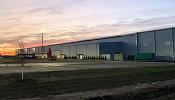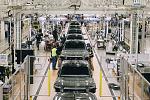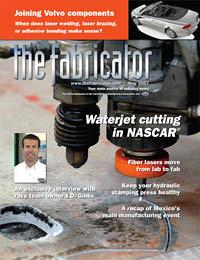Editor-in-Chief
- FMA
- The Fabricator
- FABTECH
- Canadian Metalworking
Categories
- Additive Manufacturing
- Aluminum Welding
- Arc Welding
- Assembly and Joining
- Automation and Robotics
- Bending and Forming
- Consumables
- Cutting and Weld Prep
- Electric Vehicles
- En Español
- Finishing
- Hydroforming
- Laser Cutting
- Laser Welding
- Machining
- Manufacturing Software
- Materials Handling
- Metals/Materials
- Oxyfuel Cutting
- Plasma Cutting
- Power Tools
- Punching and Other Holemaking
- Roll Forming
- Safety
- Sawing
- Shearing
- Shop Management
- Testing and Measuring
- Tube and Pipe Fabrication
- Tube and Pipe Production
- Waterjet Cutting
Industry Directory
Webcasts
Podcasts
FAB 40
Advertise
Subscribe
Account Login
Search
Making it in Mexico
TECMA 2007 opens the door to a wide open market
- By Dan Davis
- May 8, 2007
- Article
- Shop Management
Mexico and the U.S.—two countries that are separated by a river, but in some ways it can be an ocean. The metal fabricating industry is a good example of this gulf.
Just consider TECMA 2007, held March 6-9 in Mexico City. Organizers call TECMA the only tradeshow that specializes in machine tool technology and related equipment. The 12th edition of the show—and the first one in which The FABRICATOR exhibited—proved to be a learning experience:
- Unlike the early-morning starts and early-evening closings at U.S. tradeshows, TECMA 2007 opened at 11 a.m. and went until 8 p.m. each day. That fits the Mexican lifestyle in which most businesses get a later start and late-night dinners are common.
- Students are invited to the tradeshow on the first day of the event instead of the last day, which happens in the U.S. In some instances, it's hard to tell the students from the fabricating professionals because so many young people were walking the show floors.
- The bulk of attendees don't show up until the late afternoon, after they have gotten off work. Unlike their U.S. counterparts, they aren't given time off from work to attend these industry events.
Despite the different approaches to learning about fabricating technologies, Mexican and U.S. fabricators have a similar trait: They have seen manufacturing jobs disappear from their respective countries, and they are looking for more efficient ways to fabricate metal. The fabricators in Mexico—which comprise small ornamental iron gate manufacturers to giant Fortune 500 manufacturing plants—cannot compete on price alone.
But that's just the basic motivation for better shop floor practices. There's much more to Mexican manufacturing.
More on Mexico
As manufacturing shifts in the global economy have cost Mexico jobs in its maquiladora industry, the country's leaders have been much more aggressive in targeting more sophisticated manufacturing segments that might be in search of labor cost reductions but still want to stay relatively close to U.S. markets. The aerospace market is one such segment.
Eaton Aerospace moved its manufacturing operations to Tijuana, Mexico, last fall. The company, which manufactures electrical products, metal tubes, solenoid valves, and air ducts for customers such as Airbus, Boeing, Gulfstream, and Lockheed Martin, plans to employ close to 650 to 700 workers when hiring is complete.
Mike Nieves, Eaton Aerospace's director of operational excellence, told the San Diego Union-Tribune that Baja California already is home to 26 aerospace companies and employs about 60 percent of aerospace workers in Mexico.
Actual airplane assembly is taking place in Mexico as well. Bombardier opened manufacturing operations in Queretaro, Mexico, in 2005. The facility unveiled its first airplane fuselage in May 2006.
Eric Stange, president of Tools For Bending, has seen his share of aerospace-related customers move to Mexico. It's one of the reasons his company was exhibiting at TECMA 2007.
"We have a lot of customers who bend tube for customers back in the U.S.," he said.

Mexican fabricators have a thirst to learn about the latest metal fabricating equipment. In some instances, they quenched the thirst with a purchase. Vendido is Spanish for "sold."
That likely won't be changing any time soon, as more investment from all over the world works its way into Mexico, he added.
Elumatec U.S.A. Inc. shares the same sentiment. The company, which sells machinery for working aluminum, as well as vinyl/PVC profiles, for the door and window market, is looking with great interest at the Mexican market.
Steve Van Tongeren, Elumatic USA's vice president, said his company sells directly to door and window manufacturers in the U.S., but is seeking out Mexican distributors that might be interested in representing the company's line of equipment.
Such is the case in Mexico, where distributors act as the main force in introducing new manufacturing technology to the Mexican market. Names such as Grupo Disma-Mex, Hi-Tec, Mercado Machinery, and TECSA are more familiar to many in Mexico than the equipment brands they represent.
Van Tongeren said he believes opportunities exist in the door and window market in Mexico because other industries, specifically, the automotive manufacturers, are suffering.
"It's pretty shaky right now," said Ed Egner, who works with sales and service for Manchester Tool and Die Inc., a manufacturer of tube end forming machinery.
It's one of the reasons that Egner and his Mexican representatives are looking at nontraditional manufacturing segments. One such idea is to target swaging for metal fences. Egner said Manchester Tool and Die already sells tooling for the threading of solid bars, used in the manufacturing of muffler hangers in the automotive industry, and the fence application is a logical extension for that type of tooling.
Challenges for the Fabricating Base
So Mexican manufacturing is in transition—with some jobs still moving south from the U.S., but with other Mexican operations moving overseas to Asia. Mexican fabricators have other issues to deal with as well.
Jerry Kroetch, president of Scotchman® Industries Inc., said that Mexican fabricators interested in new equipment have to wrestle with commercial loan interest rates that might be as high as 20 percent. Considering the difficult financing terms with significant capital outlays for state-of-the-art fabricating equipment, shop owners think long and hard about new purchases.
But many equipment-makers see a need for the new technology and do what they can to help prospective customers. Kroetch said Scotchman offers financing rates much lower than 20 percent, but only if the Mexican machine tool distributor will vouch that the Mexican customer will be able to make payments.

TRUMPF Mexico took the opportunity to introduce a new feature on its TruLaser 2030. Instead of bulky safety doors, equipment designers scaled back the movable enclosure and decided to enclose the laser with several metal pins on each side. The pins have copper surfaces and are able to reflect the laser light should the torch mistakenly be aimed to the side, protecting the laser machine operator.
A thirst for new technology and figuring out how to get it? The scenario sounds very familiar to Gunter Glocker, president of tool manufacturer Wila USA.
"Fabricators down here suffer from the same issues [as those in the U.S.], but on a different scale," he said.
Without as much diversification in its economy, Mexico can really be hurt by the loss of manufacturing jobs, he said.
"They have lost a lot of jobs here to China," said Dave Bishop, Wila's business development manager. "But there are a lot of big jobs around Monterrey opening up."
A Need for Technology
Despite the change in the manufacturing landscape, attendees and exhibitors at TECMA 2007 appeared to be optimistic for the future.
"The economy is good here now, but it wasn't so good last year with the election," said Lara Soto Barrionuevo of Grupo Disma-Mex. "People get nervous with each election because they don't know what will happen.
"But things look good for the next six years," she added.
One would have to embrace that thought if he or she was in the market for a new laser cutting machine or turret punch press. The machine tool builders are certainly bullish on the Mexican market.
TRUMPF introduced a TruLaser 2030 that lacked the bulky safety doors of its preceding generation of equipment. Instead of the large enclosure that slid closed as the laser was in operation, metal pins with copper surfaces surround the laser and act as a barrier to prevent the laser light from getting out and potentially harming the laser cutting machine operator.
Not only did TRUMPF choose to showcase the new modification to its laser cutter at TECMA 2007, but it also formally opened the new headquarters for TRUMPF Mexico in Monterrey only a few weeks later.

Accurpress was one of many press brake manufacturers represented at TECMA 2007. Many manufacturers depend on equipment dealers to reach the Mexican fabricating community.
Just call Mexico the land of fabricating opportunity.
Source Links
Elumatec U.S.A. Inc., www.elumatec.com
Grupo Disma-Mex, www.dismamex.com.mx
Hi-Tec, www.hitec.com.mx
Manchester Tool and Die, www.manchestertoolanddie.com
Mercado Machinery,www.mercadomachinery.com
Scotchman Industries Inc., www.scotchman.com
TECSA, www.tecsa.info
Tools For Bending, www.toolsforbending.com
TRUMPF Inc., www.us.trumpf.com
Wila USA, www.wilausa.com
About the Author

Dan Davis
2135 Point Blvd.
Elgin, IL 60123
815-227-8281
Dan Davis is editor-in-chief of The Fabricator, the industry's most widely circulated metal fabricating magazine, and its sister publications, The Tube & Pipe Journal and The Welder. He has been with the publications since April 2002.
subscribe now

The Fabricator is North America's leading magazine for the metal forming and fabricating industry. The magazine delivers the news, technical articles, and case histories that enable fabricators to do their jobs more efficiently. The Fabricator has served the industry since 1970.
start your free subscription- Stay connected from anywhere

Easily access valuable industry resources now with full access to the digital edition of The Fabricator.

Easily access valuable industry resources now with full access to the digital edition of The Welder.

Easily access valuable industry resources now with full access to the digital edition of The Tube and Pipe Journal.
- Podcasting
- Podcast:
- The Fabricator Podcast
- Published:
- 05/14/2024
- Running Time:
- 62:12
Cameron Adams of Laser Precision, a contract metal fabricator in the Chicago area, joins the podcast to talk...
- Trending Articles
White House considers China tariff increases on materials

A visit to Automate 2024 reveals the future might be now

Majestic Steel Arkansas fully operational

Rivian to expand Illinois facility to manufacture midsized SUV

Why employee-owned companies make sense in manufacturing

- Industry Events
Laser Welding Certificate Course
- May 7 - August 6, 2024
- Farmington Hills, IL
World-Class Roll Forming Workshop
- June 5 - 6, 2024
- Louisville, KY
Advanced Laser Application Workshop
- June 25 - 27, 2024
- Novi, MI
Precision Press Brake Certificate Course
- July 31 - August 1, 2024
- Elgin,




























